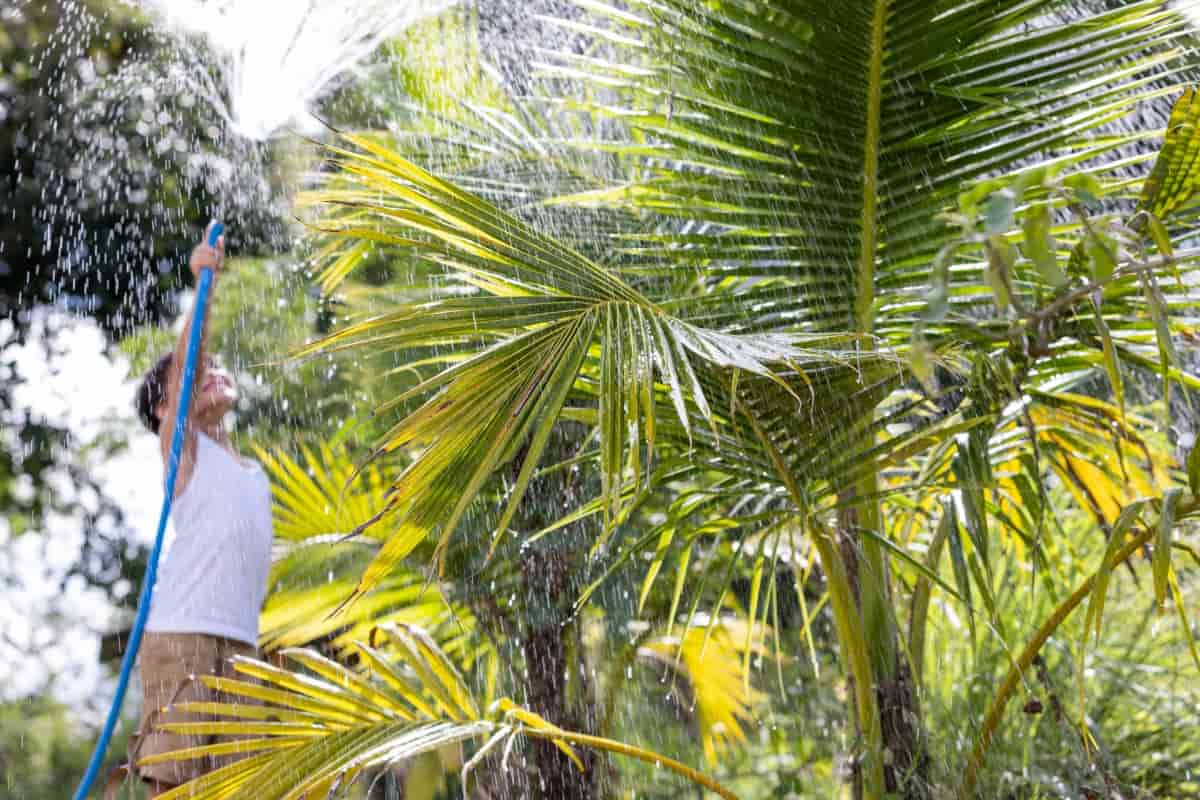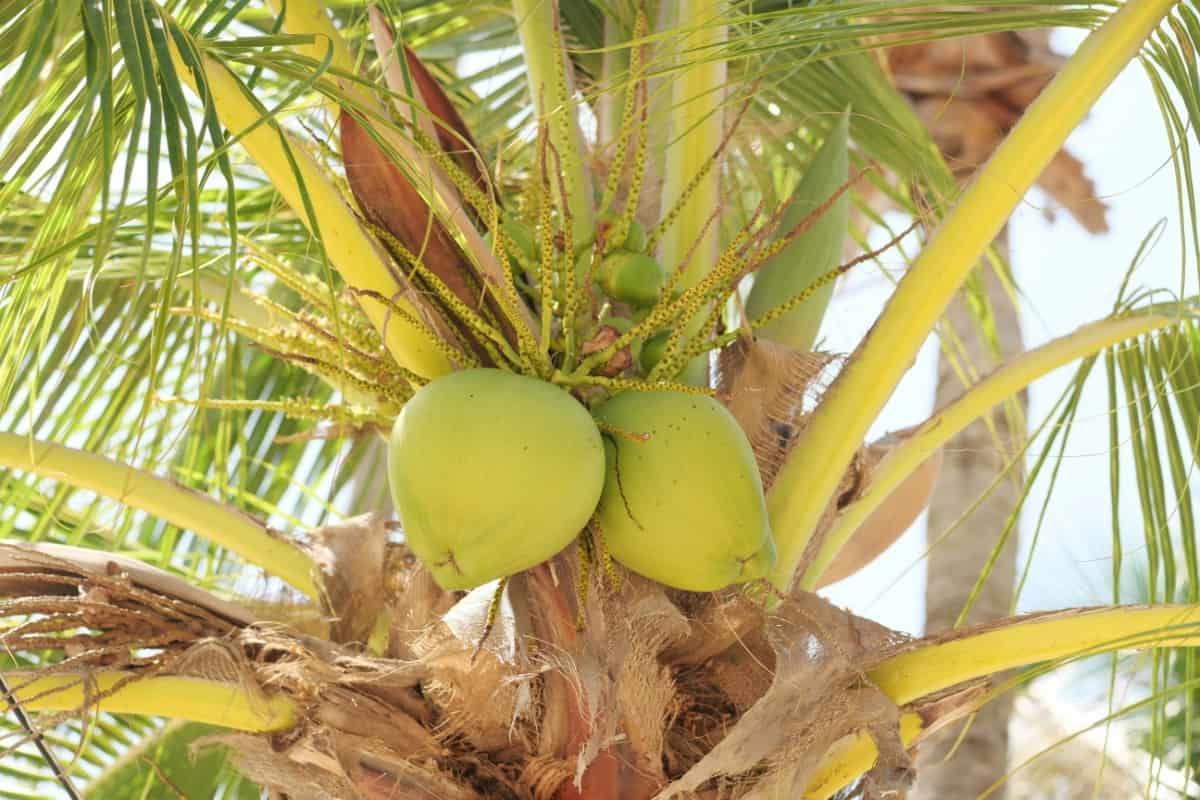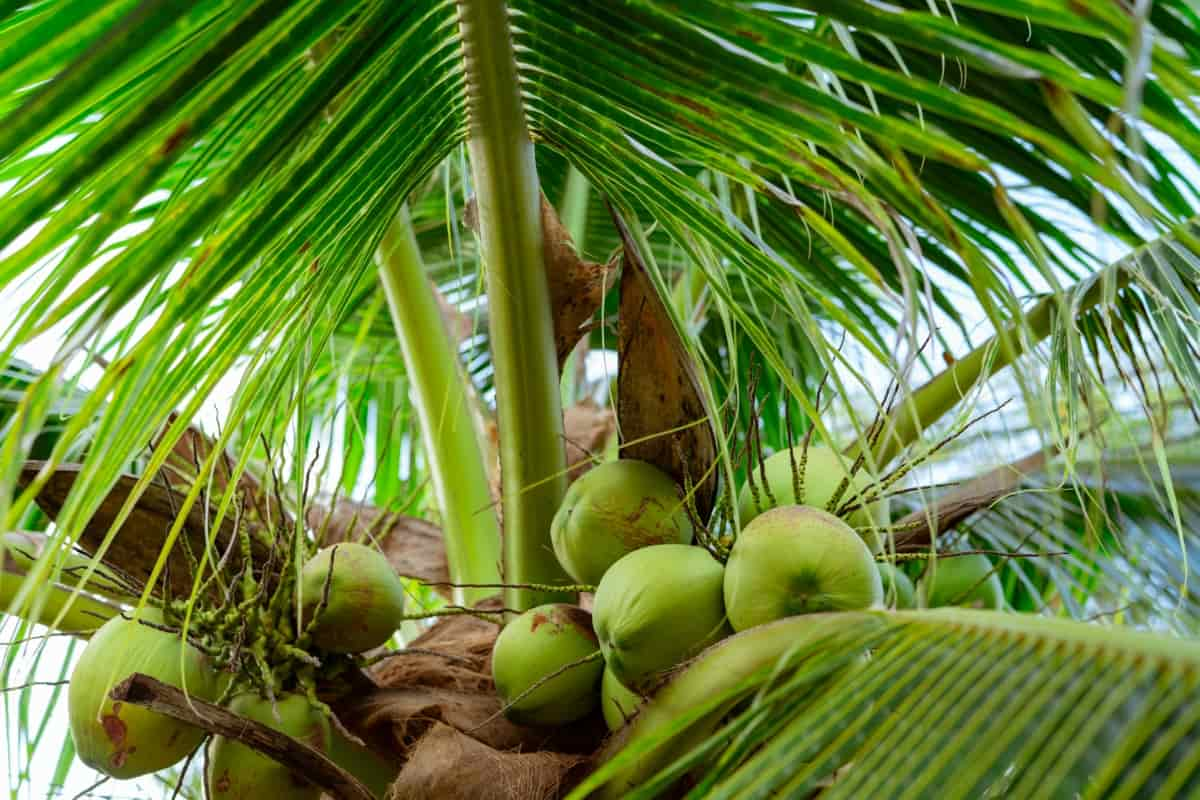Are you worried about yellowing coconut palm leaves? Discover why this happens and how to treat it effectively. Nutrient deficiencies, watering issues, pests, diseases, soil pH imbalance, environmental stress, root-bound conditions, poor drainage, sunlight inadequacy, and chemical damage can all contribute to yellow leaves. Combat these issues with organic remedies and proper care tips. From adjusting watering practices to using natural pest control methods, learn how to revive your coconut palm’s health.

Coconut Palm Leaves Turning Yellow
Nutrient Deficiencies
Coconut palms need a balanced fertilizer that contains nitrogen, phosphorus, potassium, magnesium, iron, manganese, and other micronutrients. If they lack any of these essential nutrients, their leaves may turn yellow or show other symptoms of deficiency. To prevent or correct nutrient deficiencies, apply a slow-release palm fertilizer three or four times a year, following the label instructions. Do soil tests to determine the exact nutrient levels of the soil and adjust accordingly.
Improper Watering Practices
Coconut palms like moist but well-drained soil. Overwatering and underwatering can cause stress and damage to the roots, resulting in yellow leaves. To avoid overwatering, check the moisture level before watering and water only when the top 2 inches of soil feel dry. To avoid underwatering, water deeply and thoroughly until water drains out of the pot or the soil is saturated. During hot or dry seasons, you may need to water more frequently than usual.
Pest Infestations
Various pests, such as spider mites, mealybugs, scale insects, aphids, and whiteflies, can attack coconut palms. These pests mostly suck the sap from the leaves and reduce the plant’s vigor, causing yellowing or browning of the leaves. To control pest infestations, inspect your coconut palm regularly and remove any pests by hand or with a blast of water. Use organic insecticidal soap and neem oil spray to kill the pests and prevent further damage.
Diseases and Fungal Infections
Coconut palms can also suffer from diseases and fungal infections that affect their health and appearance. Some common diseases are leaf spots, root rot, bud rot, lethal yellowing, and Ganoderma butt rot. These diseases can cause yellowing, wilting, browning, or dying of the leaves or other parts of the plant.
In case you missed it: Why Moringa Flowers Turning Red: Causes, Solutions, and Care Tips

To prevent or treat diseases and fungal infections, keep your coconut palm in good condition by providing adequate water, light, nutrients, and air circulation. You can also prune off any infected or dead parts of the plant and dispose of them properly. For severe cases, you may need to apply a fungicide or contact a professional arborist for help.
Soil pH Imbalance
Coconut palms prefer slightly acidic soil with a pH of The soil pH for coconut palms is 5.5 to 6.5. If the soil pH is too high or too low, affect the availability of nutrients and cause yellowing of the leaves. To check your soil pH, you can use a pH meter or a pH test kit from a garden center or online. To adjust your soil pH, you can use natural amendments such as sulfur, lime, peat moss, or compost. Follow the instructions on the product and an expert for guidance.
Environmental Stress
Coconut palms are sensitive to environmental stress factors such as extreme temperatures, wind, salt spray, pollution, or physical damage. These factors can cause yellowing or browning of the leaves or other signs of stress, such as leaf curling, drooping, or falling off. To protect your coconut palm from environmental stress, choose a suitable location that provides enough sunlight but not too much heat or cold. You can also use mulch, shade cloth, windbreaks, or frost blankets to moderate the temperature and moisture around your plant.
Root Bound Conditions
Root-bound conditions cause coconut palm leaves to turn yellow due to the roots growing too large for the container, unable to absorb enough water and nutrients. This leads to stunted growth, reduced flowering, and increased susceptibility to pests and diseases. To identify root-bound symptoms, gently lift the palm out of its container and examine the roots, observing a dense mass of roots circling the pot’s edge.
Repotting and Root Pruning Techniques to Treat Root-bound Palms
- Repot in a larger container with fresh potting mix and prune some roots to encourage new growth.
- Cut off about one-third of the root mass, leaving healthy ones intact.
- Replant the palm in the new container, water it well, and place it in a bright location.
Poor Soil Drainage
Poor soil drainage is a significant issue that can cause the yellowing of coconut palm leaves. This is due to the soil’s inability to drain properly, leading to waterlogging or soggy conditions. This can cause root rot, fungal infections, nutrient leaching, and oxygen deprivation. To assess soil drainage, dig a hole 12 inches deep, 6 inches wide, fill it with water, and wait for it to drain completely. If it takes more than 4 hours, the soil has poor drainage.
To improve soil drainage, amend the soil with organic matter like compost, peat moss, or perlite. These materials can loosen the soil texture, increase porosity, and enhance water-holding capacity. Additionally, raise the planting bed by adding more soil and creating a slope or mound for water drainage.
Lack of Sunlight
Coconut palm leaves turn yellow due to lack of sunlight, which is essential for their growth, flowering, and fruiting. Sunlight is crucial for coconut palms as it provides energy for growth, flowering, and fruiting. Without enough sunlight, coconut palms may have reduced growth rates, lower yields, poor quality fruits, and increased susceptibility to pests and diseases.
To ensure adequate sunlight, plants require a sunny spot with at least 6 hours of direct sunlight per day and prune nearby trees or shrubs that cast shade on the palm. Pruning can improve air circulation and reduce fungal infections.
Chemical Damage
Coconut palm leaves turn yellow due to chemical damage, which can be caused by harmful chemicals like herbicides, pesticides, fertilizers, or salt. Identifying chemical exposure is easy, and flushing the soil with water can help remove excess chemicals. Nutrient deficiencies, such as nitrogen, potassium, magnesium, and manganese, can also cause yellowing. Without enough nitrogen, older leaves may turn yellow, stunted growth, reduced flowering, and poor fruit quality.
In case you missed it: 10 Reasons Why Pomegranate Tree is Not Blooming and Fruiting: Remedies and Treatment

Potassium is crucial for water balance, sugar transport, and disease resistance. Magnesium is essential for chlorophyll formation and enzyme activation. Manganese is essential for chlorophyll synthesis and enzyme activation. To treat nutrient deficiencies, apply a balanced fertilizer containing all essential nutrients or use organic or natural sources like compost, manure, or seaweed. Follow label instructions and avoid over-fertilization.
Organic Remedies for Coconut Palm Care
- Fertilize the palms with a slow-release fertilizer containing nitrogen, phosphorus, potassium, magnesium, and micronutrients four to five times a year, keeping it away from the trunk.
- Water the palms regularly, especially during dry seasons, to prevent root rot and fungal infections.
- Prune the palms only to remove dead or diseased fronds, as excessive pruning can weaken the tree and expose it to pests and diseases.
- Spray neem oil or horticultural oil to control common pests like spider mites, mealybugs, scale insects, and whiteflies.
- Apply fungicides like copper or sulfur to prevent or treat fungal diseases like leaf spot, bud rot, stem bleeding, and lethal yellowing.
- Mulch the palms with organic matter to conserve soil moisture and suppress weeds.
- Protect the palms from cold temperatures by wrapping the trunk with blankets or burlap, covering the canopy with frost cloth, or moving them indoors.
In case you missed it: How to Get Rid of Moringa Fruit Fly: 100% Effective Treatment for Drumstick Fruit Fly

Conclusion
Yellowing coconut palm leaves can result from various factors like nutrient deficiencies, watering problems, pests, diseases, and environmental stress. By addressing these issues with organic remedies and proper care techniques, you can restore your palm’s health and enjoy lush green foliage for years to come.
- Beneficial Insects in Pest Management
- Natural Solutions for Pest Control in Flower Gardens
- Types of Fungicides Used in Agriculture
- Common Issues in the Fruit Development Stage of Pomegranate Farming
- Fruit Development Issues in Papaya: Easy Solutions and Treatment
- Soil-Borne Diseases and How to Protect Your Plants
- Practices to Prevent Disease Spread in the Garden
- From Wilted to Thriving: How to Treat Root Rot Naturally in Houseplants
- Natural Remedies to Cure Brown Spots on Fig Tree Leaves